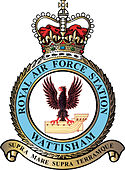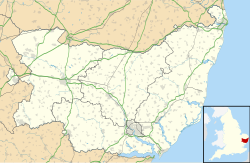RAF Wattisham
| RAF Wattisham USAAF Station 377 USAAF Station 470 |
|
|---|---|
  |
|
| Stowmarket, Suffolk, England | |
 |
|
| Coordinates | 52°07′41″N 0°57′22″E / 52.128°N 0.956°E |
| Type | Royal Air Force station |
| Site information | |
| Owner | Ministry of Defence |
| Controlled by |
|
| Site history | |
| Built | 1938 |
| Built by | John Laing & Son Ltd |
| In use | 1939-1993 |
| Battles/wars | Second World War, Cold War |
| Garrison information | |
| Garrison |
RAF Bomber Command Twelfth Air Force Eighth Air Force RAF Fighter Command RAF Strike Command |
| Occupants |
No. 2 Group RAF 68th Observation Group 479th Fighter Group |
| Airfield information | |||||||||||
|---|---|---|---|---|---|---|---|---|---|---|---|
| Summary | |||||||||||
| Runways | |||||||||||
|
|||||||||||
Royal Air Force Station Wattisham or more simply RAF Wattisham (ICAO: EGUW) is a former Royal Air Force station located in East Anglia just outside the village of Wattisham, south of Stowmarket in Suffolk, England. During the Cold War it was a major front-line air force base before closing in 1993 and is now operated by the British Army as Wattisham Airfield.
RAF Wattisham opened on 5 April 1939 as a medium bomber station, the squadrons there being equipped with Bristol Blenheim bombers. Part of No. 2 Group, No. 107 Squadron RAF and No. 110 Squadron RAF were stationed there on the outbreak of war as No. 83 Wing. On 4 September 1939, just 29 hours after the declaration of war, bombers from Wattisham took off on the first attack of the war, against enemy shipping in Wilhelmshaven harbour.
The following squadrons and units also were based at Wattisham at some point during this time:
In September 1942 the base was handed over to the United States Army Air Forces.
Wattisham was assigned USAAF designation Station 377, and work began on building concrete runways with the intention of adapting the airfield for heavy bomber use. However, plans were apparently changed when it was evident that there would be sufficient heavy bomber airfields available for the USAAF, and it was decided that Wattisham would remain an air depot and also house a fighter unit.
Work ceased on the runways leaving only the E-W with a concrete surface and short stretches of the other two. The main SW-NE runway was finished off with steel matting while the remaining NW-SE runway continued to be grass-surfaced for most of its length.
...
Wikipedia

